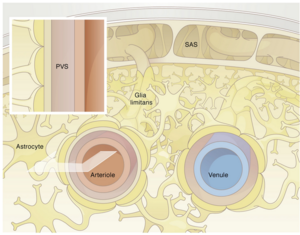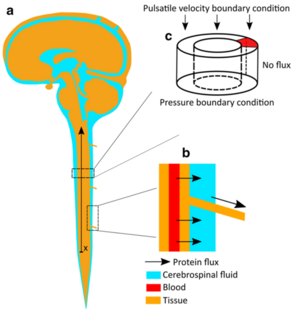Research
Water and solute dynamics in the brain
This project aims at developing numerical models of water and solute transport in the brain. The envisioned models will be based on data from a range of imaging and other experimental modalities, taking into account the relevant anatomy, known and suspected fluid transport routes as well as driving mechanisms. Ultimately, the models will be used to test existing and devise new hypotheses of cerebral water and solute transport.
Background
Cerebral tracer studies have revealed the convective flow of particles in the perivascular space surrounding arteries. Being adjacent to the narrow, high resistance extracellular space in the brain tissue, the perivascular space is thought to act as a fast lane for the transport of water and solutes. Connection between this fast lane and the slower extracellular fluid space is established through Aquaporin 4 (AQP4) water channels, which are predominantly expressed in the glial end-foot and feature high water conductivity. We have established a computational fluid dynamics (CFD) framework to study the interplay between the perivascular space, AQP4 and extracellular fluid space in cerebral water and solute transport.
Project goals
The CFD framework will be further developed to:
- Evaluate the role of AQP4 water channels and their polarization in the vicinity of large fluid compartments
- Assess the role of the perivascular space network in facilitating cerebral water and solute transport
- Test existing hypotheses of fluid driving mechanisms in the perivascular space and cerebral tissue
Related Publications
- Barrier dysfunction or drainage reduction: differentiating causes of CSF protein increase Fluids and Barriers of the CNS, 14(1), (2017).
- Glymphatic solute transport does not require bulk flow Scientific Reports, 6(38635 ), 1 – 11 (2016).
- How astrocyte networks may contribute to cerebral metabolite clearance Scientific Reports, 5, 15024 (2015).


